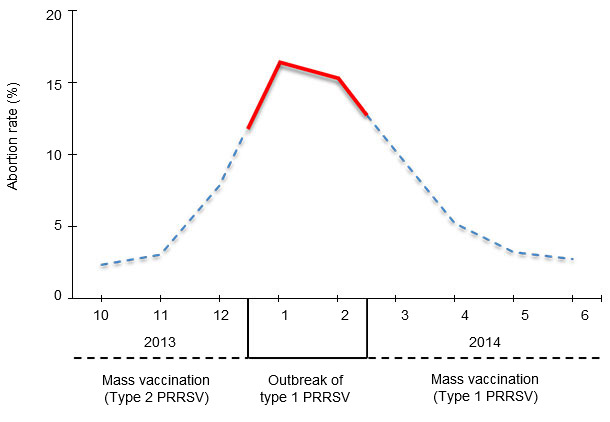Porcine reproductive and respiratory syndrome (PRRS) is one of the most important challenges currently facing the Korean swine industry. PRRS virus (PRRSV) is divided into type 1 (European) and type 2 (North American) genotypes. Type 1 and type 2 PRRSVs differ significantly in terms of their clinical, genetic, and antigenic properties. Currently, both genotypes circulate concurrently in Korea. Since emergency of type 1 PRRSV in 2005, a type 1 PRRSV infection is clinically characterized by reproductive failure in sows and respiratory disease in growing pigs of all ages, causing huge economic losses. Type 1 strains can cause abortions and near-term delivery of stillborn fetuses in pregnant gilts, like type 2 strains.
In Korea, most independent farms raise pigs in all-in-all-out one-site systems although large integrated farms operate as two-site systems; breeding, gestation, and farrowing/nursery at one site, and grow/finish pigs at a separate site. Because of high prevalence of PRRSV seropositive farms (@ 70%), pig farmers prefer to vaccinate gilts and sows commonly for the stabilization of PRRS in breeding herds. The purpose of stabilizing the breeding herd by vaccination is to produce negative non-infected offspring at weaning from a previously infected sow population. Therefore, mass vaccination is commonly used to stabilize the breeding herds.


A 110-sow farrow-to-finish pig herd experienced an acute reproductive outbreak of type 1 PRRSV infection. The history of reproductive failure caused by PRRSV was summarized in Figure 1. The owner had vaccinated sows for 3 years as a whole-herd mass vaccination program, in which all sows were vaccinated quarterly with type 2 PRRSV vaccine as recommended by the manufacturer. The most recent whole-herd mass vaccination of all sows with type 2 PRRSV vaccine was conducted on 5 January in 2014. The outbreak was characterized by stillborn piglets in 14 of 20 (70%) gilt litters and in 6 of 23 (26.1%) sow litters over an 8 week period (mid-December, 2013 to mid-February, 2014). Pregnant gilts and sows farrowed 6 to 10 stillborn piglets per litter. Total numbers of stillborn piglets were 160 out of 507 pigs (31.6%). Three litters were born 3-4 days early without stillborn piglets. Affected females were anorexic and demonstrated fevers of 40.0 to 41.4oC. All sows and gilts that farrowed stillborn piglets showed agalactia. Four out of 23 sows that farrowed normal piglets showed agalactia. All sows and gilts farrowing stillborn piglets did not return to estrus. Seven gilts and 2 sows were culled because of no return to estrus. The 30% of sows and gilts that farrowed normal piglets had a delayed return to estrus postweaning. One sow died post farrowing. From many litters, 45 weakborn piglets from 507 liveborn piglets were observed during this outbreak. Nursery mortality was approximately 20%.
Twelve stillborn piglets from each of 8 gilts and 4 sows were submitted to the Department of Veterinary Pathology in Seoul National University. Type 1 virus was detected in 11 of 12 stillborn piglets by PCR. Type 1 virus was isolated in thymus and lymph node from stillborn piglets.
In March 2014, the whole-herd was vaccinated twice with type 1 PRRSV vaccine with a three week interval between doses. After vaccination, the number of stillborn piglets was significantly reduced. Two sows farrowed a total of 14 stillborn piglets and 9 normal piglets. Four out of 85 sows were delayed in their return to estrus. Thereafter, no reproductive failures were observed in breeding females. Mild respiratory disease developed in 80- to 120-day old pigs.
Clinical manifestation of type 1 PRRSV infection is mainly associated with reproductive failure, which manifests itself as an abortion storm in sows in Korea. Thus, control of type 1 PRRSV in sows is critical to prevent economic losses by reproductive failures. Type 2 PRRSV vaccines have been used in this affected herd. Clinical signs of reproductive failure in the herd suggest incomplete cross protection of type 2 PRRSV vaccine against type 1 PRRSV. In Korea, it is common to vaccinate sows as a whole-herd mass vaccination program, where all sows are vaccinated quarterly with a type 2 PRRSV vaccine. Therefore, it is recommended to vaccinate breeding females quarterly with additional type 1 PRRSV vaccine to control type 1 PRRSV infection.






